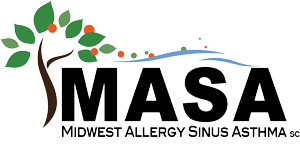
Sinuses are hollow cavities located in your skull, and they produce mucus to moisturize your nose. But when you’re sick, have chronic sinus problems, or if you have allergies, pressure can build up.
You might experience frustrating, painful symptoms ranging from facial pressure to the inability to smell. These sinus symptoms can quickly make life miserable and keep you from feeling like your best self, but with expert care, you can find relief from some of the most bothersome sinus problems.
At Midwest Allergy Sinus Asthma, Dareen Siri, MD, and her team of advanced practice providers are experts in sinus care. We regularly recommend diagnostic nasal endoscopy procedures for patients who are living with sinusitis and other sinus issues. We’re here to help you find relief from persistent sinus problems.
The purpose of nasal endoscopy
Nasal endoscopy is a diagnostic test that involves inserting a small camera inside your nose and sinuses. The camera captures images that are projected on a larger screen. This test lets Dr. Siri and her team look inside your nose to evaluate a range of common sinus problems.
You might need a nasal endoscopy if you suffer:
- Frequent sinus infections
- Facial pressure or pain
- Sinus headaches
- Difficulty breathing through your nose
- Frequent nosebleeds
- Excessive nasal drainage
- Loss of your sense of smell
Inflammation, polyps, nasal masses, or other blockages can interfere with breathing and cause a range of unpleasant symptoms. During nasal endoscopy, Dr. Siri looks for anything abnormal inside your nasal cavity and sinuses.
Nasal endoscopy is a helpful diagnostic tool because it gives us an inside look into your nose and face, without the need for surgery. Once we identify the cause of your symptoms, we can make the best recommendations for treatment.
What to expect with nasal endoscopy
If Dr. Siri recommends nasal endoscopy, we give you guidelines before the procedure that might include temporarily stopping blood-thinning medications. Most of the time, patients can eat and drink normally before nasal endoscopy.
When you come into the office for your nasal endoscopy, we begin by spraying a topical decongestant or administering anesthetic inside your nose. You’re awake for the entire procedure as you sit upright in an exam chair.
We begin the nasal endoscopy once the anesthetic takes effect. The endoscope is a long, thin device with a camera on the end that allows Dr. Siri to see inside your sinuses and nasal cavity.
She inserts the endoscope into one nostril and directs it back into your sinus. She may perform a few different passes in each nostril to get a full view, but the entire procedure usually takes less than five minutes.
Nasal endoscopy is generally low-risk. Side effects may include nosebleed or fainting, but we’re here to keep you comfortable throughout the procedure. Most of the time, patients can leave the office shortly after the nasal endoscopy is complete. There’s no downtime, and you can expect to return to your normal daily activities immediately.
Depending on the results of your nasal endoscopy, we might recommend allergy treatment, nasal saline rinsing, or medication to manage symptoms.
Find comprehensive sinus care with our team at Midwest Allergy Sinus Asthma. Schedule your first appointment by calling one of our Illinois offices today to learn more about diagnosis and treatment of sinusitis.
